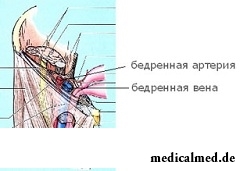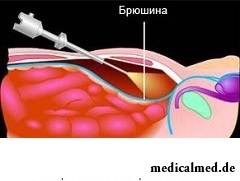





Femoral hernia
Femoral hernia – tumorous education which is formed at an exit of loops of an epiploon and intestines out of limits of an abdominal cavity through a femoral ring. Femoral hernia is shown by existence of a tumor, pain.
Femoral occurs among total number of hernias of a stomach approximately in 5-8% of cases. Are more subject to development of femoral hernia of the woman. At men femoral hernia develops four times less often. It is connected with anatomic features of a body. Sometimes, that the disease develops at small children of the first year of life in connection with physiological weakness of fabrics of an abdominal wall.
The most common causes of formation of femoral hernia
Weakening of an abdominal wall is the main reason of femoral hernia. In turn, often lead the following factors to weakening of an abdominal wall: injuries of an abdominal wall, post-operational hems, hip dislocations, disturbance of an innervation of an abdominal wall. Development of femoral hernia in men is promoted by excessive exercise stresses, and to development of femoral hernia in women – numerous pregnancies and long childbirth.
Often lead the situations connected with continuous increase in intra belly pressure to developing of a disease: the complicated urination, physical effort, a constant severe cough, locks, etc. And, developing of hernia can develop even after single rise in weight, or develop against the background of long cough (for example, at chronic bronchitis).
Types of femoral hernias
Femoral hernias in the location divide on bilateral and unilateral. According to clinic allocate the unreducible, reducible and restrained femoral hernias.
Unreducible hernias or are set not completely, or at all do not give in to reposition in an abdominal cavity. The restrained femoral hernias are characterized by a hernia contents prelum hernial gate that is very dangerous as there is a probability of acute intestinal impassability, peritonitis, gangrene of a gut or necrosis.
Process of formation of femoral hernia has three stages:
- Initial when the hernial bag is outside an internal femoral ring. At this stage it is heavy to diagnose a disease, but it can be expressed in a partial enterocele.
- Incomplete stage when the tumor is in the femoral channel, in borders of a front fascia.
- Full stage which is characterized by protrusion of hernia from the femoral channel in hypodermic cellulose of a hip. In a full stage femoral hernia at women can stick out in vulvar lips. At men femoral hernia can stick out in a scrotum.
Symptoms of femoral hernia
At the first and second stage the disease is characterized by hernial protrusion in an inguinofemoral fold. The tumor, as a rule, has the small sizes, rounded shape and a smooth surface. Especially it is noticeable in vertical position or at a tension. After reposition disappears with the characteristic humming sound.
In the presence in hernial looping of intestines the tympanites is defined. In the presence of femoral hernia there can sometimes be a hypostasis of the lower extremity caused by a prelum of a femoral vein and which is followed by numbness and feeling of "goosebumps on a body". If the bladder gets to a hernial bag, dysuric frustration can develop.
Its inflammation belongs to complications of femoral hernia. The inflammation can be both purulent, and serous. First of all there is a hernia contents inflammation (a gut, an appendix, uterus appendages, etc.). The inflammation can sometimes pass to a hernial bag from integuments. The inflamed hernia causes a feeling of pain, a dermahemia, the increased body temperature. Development of peritonitis is in certain cases possible.
The restrained femoral hernia is fraught with development of an innervation of the bodies which are in hernia or an acute disorder of blood circulation. These symptoms are followed by increase in hernia in sizes and its consolidation. There are severe pains in a stomach, the delay of gases and a chair develops. This state can result in intestinal impassability and a necrosis, shown in nausea, colicy pains, a hiccups, repeated vomiting.
How diagnose femoral hernia?
At initial stages it is quite difficult to diagnose a disease as there are no pronounced symptoms. As a rule, diagnose femoral hernia after manifestation of typical symptomatology (characteristic protrusion in the field of a femoral triangle, a symptom of a tussive push, a vpravlyaemost in horizontal position, etc.).
At a palpation of hernial education it is possible to define character of its contents, degree of a vpravlyaemost of hernia and to specify the sizes of the hernial channel. In the course of diagnosis femoral hernia needs to be differentiated from congestive abscess, inguinal hernia, a varicosity, a lipoma, thrombophlebitis, metastasises of cancer tumors, etc.
Ultrasonography and irrigoskopiya helps to define contents of a hernial bag.
Treatment of femoral hernia
Conservative treatment of femoral hernia is impossible therefore in the presence of a disease only an operative measure is shown. The most widespread method of an operative measure – a hernioplasty (herniotomy with defect plastics).
Operation for treatment of femoral hernia assumes opening of a bag with contents of hernia and its careful survey, and if necessary – removal of an epiploon and reposition of contents of hernia in an abdominal cavity. Further bandaging, excision of a hernial bag and plastic of the hernial channel follows. The hernioplasty is carried out as using synthetic materials, and own tissues of the patient.
At the restrained femoral hernia often carry out a median laparotomy with removal of the impractical site of intestines.
In most cases the forecast at treatment of femoral hernia favorable, patients can return to usual life.
The most high temperature of a body was recorded at Uilli Jones (USA) who came to hospital with a temperature of 46,5 °C.

Obesity is called by a disease of 21 centuries, for the last 100 years by the number of the people suffering from excess body weight, considerably increased...
Section: Articles about health
Dark circles (bruises) under eyes – a shortcoming with most of which often fight against the help of cosmetics (proofreaders, saloon procedures and so forth), eliminating only its visibility. However, according to doctors, skin around eyes – the indicator of many disturbances in an organism...
Section: Articles about health
Coffee – favourite drink of many. For the last decades it more than once already declared very harmful, extremely useful and even necessary for normal life activity. In spite of the fact that this product became for us usual for a long time, there are many myths about properties of coffee and its impact on a human body. Readers can get acquainted with the most widespread of similar delusions today....
Section: Articles about health
For the last decades the diabetes mellitus of the second type became really world problem. Number of cases annually cart...
Section: Articles about health
Scientists always aimed to offer fundamental explanations for medical problems. Their theories formed the basis of modern methods of treatment of the hardest pathologies and helped to save a set of lives. However stories are known also such theoretical constructions, following to...
Section: Articles about health
Water with a lemon - idle time in preparation drink which supporters of a healthy lifestyle already managed to appreciate. Used in a warm look and on an empty stomach, it is one of the most useful prophylactics allowing to prevent tens of diseases and just to raise an organism tone. Especially effectively to use warm water with lemon juice after a serious illness, during a season of the colds, and also to children, old men and pregnant women which do not have contraindications...
Section: Articles about health
All like to sing. Small children with pleasure are engaged in a vocal, not especially thinking of hit in a melody. Adults most often...
Section: Articles about health
Each woman has preferences in the field of use of those goods which help us to look good, feel young and effective. Besides: selection process of favourite perfume, shampoo or decorative cosmetics already lifts a spirit...
Section: Articles about health
Frosty air, fresh wind and easy snowball at most of Russians are associated with cheerfulness, health and cheerful entertainments on which our winter is so generous. But, unfortunately, cold season sometimes brings also troubles with health. It is not about seasonal colds and frostbites, and about those chronic illnesses which symptoms are shown preferential in the winter....
Section: Articles about health
Smack in a mouth can arise in the natural way – as a result of lack of morning hygiene or reception of the corresponding food. Odn...
Section: Articles about health
A little more than a century ago goat milk was a traditional food stuff of most of Russians. Unfortunately, today on tables of our compatriots it appears extremely seldom. The reason that the use of so useful product practically descended on...
Section: Articles about health
When overcomes feeling of hunger, and an opportunity to have dinner fully is absent, having a snack − the meals, small on volume, stabilizing sugar level in blood comes to the rescue. The relation of nutritionists to having a snack more often negative, but only because as snack people choose the most caloric products with the increased amount of "bystry" carbohydrates: cookies, rolls, chips, candies. Nevertheless, the advantage of having a snack is obvious to weight loss: the person avoids strong feeling of hunger...
Section: Articles about health
Tick-borne encephalitis – one of the most dangerous viral diseases which causative agents transfer and is given to people by ixodic mites. Эт...
Section: Articles about health
Sugar - the digestible refined product which is not of special value for an organism of the modern person. The use of sugar in food is based rather on the psychological dependence caused by desire to indulge itself with something tasty, and in дальнейш...
Section: Articles about health
Coffee - the tonic loved by many for the invigorating aroma and deep taste. Having the stimulating effect, coffee increases working capacity, promotes concentration of attention, fights against drowsiness and improves mood. Statistically, about 30% of inhabitants of the planet regularly use coffee, from them more than 8% are "coffee-achievers" - the persons using more than 3 cups of drink a day....
Section: Articles about health
Extracorporal fertilization – one of the most modern methods of controlling with infertility. So far it already helped znach...
Section: Articles about health
Iodine - one of thirty most important microelements in our organism. The main role of iodine consists in synthesis of thyroid hormones of a thyroid gland - the substances which are responsible for the majority of exchange processes of an organism. It is known that thyroid hormones consist...
Section: Articles about health
Not everyone can brag of the shining Hollywood smile. Even the person who is regularly visiting the stomatologist and watching of oral cavities over health periodically has problems: enamel of teeth darkens under the influence of some products, on it the deposits giving to teeth a grayish or yellowish shade collect....
Section: Articles about health
Each of us repeatedly noticed that the people having the same passport age are sometimes not similar on one-years at all. One...
Section: Articles about health
Summer in the heat. Many are going to spend vacation abroad. Travelers the tender seas, rest on beaches wait, for sightseeing, campaigns on natural and cultural reserves. But, unfortunately, on vacation also problems about health can wait for us...
Section: Articles about health
Life of the modern woman is very difficult. Opportunities to realize itself are wide: it not only education and career, but also the most various hobbies from sport before needlework. It is not less important to build private life, paying an attention maximum to children, the husband, parents, friends. For all these affairs there is catastrophically not enough time therefore each of us tries to cut down as far as possible its expenses on necessary, but not the most fascinating housework. With it we are successfully helped by means...
Section: Articles about health
The mankind knows that some toxins at intake in the minimum quantities have therapeutic effect...
Section: Articles about health
From the failure of work of immune system which is shown in the form of an allergy, statistically, more than 40% of the population of the globe suffer. In most cases pathological reactions cause the substances which are contained in food stuffs, hair of animals, medicines...
Section: Articles about health
Maternal milk is the best food for the newborn. It is the unique natural product containing an optimum set of nutrients, and which is best adapted in order that the baby normally developed and it was protected from harmful factors of external environment, unusual for it. Unfortunately, breastfeeding process not always does without complications. Sometimes, that the kid begins to bite a breast, giving to mother an essential inconvenience. Some women...
Section: Articles about health
You are office worker, the driver, the fan of winter sports or do not think of life without bicycle? You conduct a slow-moving image жизн...
Section: Articles about health
The unpleasant feelings connected with spring breakdown are familiar almost to each of us. Often happens that in March-April on the person weakness leans: he suffers from drowsiness, complains of bad mood, loss of interest in life and failures in affairs....
Section: Articles about health
Wood louse – the ordinary-looking unpretentious plant extended in all territory of our country. It quickly expands, and sometimes fills sites, bringing a lot of chagrin to gardeners. Perhaps, they would be upset less if knew that the wood louse is valuable medicinal raw materials. A, C and E vitamins, organic acids, tannins, wax, saponins, lipids, mineral salts and essential oils are its part....
Section: Articles about health
